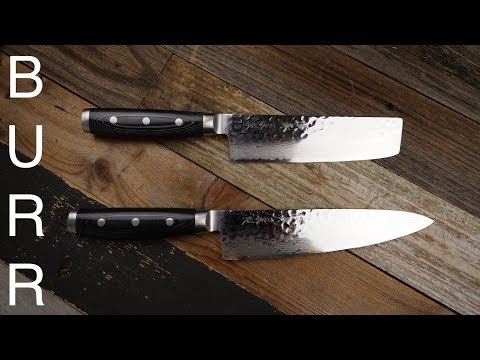
5707da6bbb12f3340f42d66bfe7fd5b3
Are you looking for the perfect knife for your kitchen? If so, you may be considering a Nakiri or Usuba knife. Both of these knives are popular in Japanese cuisine, and they each have their own unique advantages. In this article, we’ll explore the differences between Nakiri and Usuba knives, so you can decide which one is best for you.
Is Nakiri or Usuba better
When it comes to Japanese kitchen knives, two of the most popular types are the Nakiri and the Usuba. Both knives are used for cutting vegetables, but they have some distinct differences that make them better suited for different tasks.
The Nakiri is a double-beveled knife with a rectangular blade. It is designed for chopping vegetables and has a flat edge that makes it easy to cut through vegetables in a single stroke. The Usuba, on the other hand, is a single-beveled knife with a thinner blade. It is designed for precision cutting and is often used for making thin slices and intricate cuts.
When it comes to deciding which knife is better, it really depends on the task at hand. If you are looking for a knife to chop vegetables quickly and easily, then the Nakiri is the better choice. However, if you need to make precise cuts and slices, then the Usuba is the better option.
In terms of durability, both knives are made from high-quality materials and are designed to last. The Nakiri is usually made from stainless steel, while the Usuba is usually made from carbon steel. Both knives are also easy to sharpen and maintain.
In conclusion, both the Nakiri and Usuba are excellent knives for cutting vegetables. The Nakiri is better suited for chopping vegetables, while the Usuba is better for making precise cuts and slices. Both knives are also durable and easy to maintain.
What is a Nakiri knife best for
A Nakiri knife is a traditional Japanese vegetable knife. It is characterized by its rectangular blade, which is double-beveled and has a flat cutting edge. The blade is usually made of stainless steel and is typically between 5 and 7 inches long. The handle is usually made of wood or plastic and is designed to provide a comfortable grip.
The Nakiri knife is best used for slicing, dicing, and chopping vegetables. Its flat blade allows for a clean cut and prevents vegetables from sticking to the blade. The blade is also thin enough to make precise cuts, which is ideal for making thin slices of vegetables. The handle is designed to provide a comfortable grip, making it easy to maneuver the knife.
The Nakiri knife is also great for mincing herbs and garlic. Its thin blade allows for a fine mince, which is perfect for adding flavor to dishes. The handle is designed to provide a secure grip, making it easy to control the knife while mincing.
The Nakiri knife is also great for making decorative cuts. Its thin blade allows for precise cuts, which is perfect for making julienne, brunoise, and chiffonade cuts. The handle is designed to provide a comfortable grip, making it easy to maneuver the knife while making decorative cuts.
Overall, the Nakiri knife is a great tool for slicing, dicing, chopping, mincing, and making decorative cuts. Its thin blade and comfortable handle make it easy to use and perfect for preparing vegetables, herbs, and garlic.
Is a santoku better than a Nakiri
When it comes to kitchen knives, there are many different types to choose from. Two of the most popular are the santoku and the nakiri.
Both are Japanese-style knives, but they have different uses and features. So, which one is better?
The santoku is a versatile knife that can be used for a variety of tasks. It has a wide blade with a curved edge, which makes it ideal for slicing, dicing, and chopping. The nakiri, on the other hand, is a vegetable knife with a straight blade. It is designed specifically for cutting vegetables, and its thin blade makes it easier to make precise cuts.
When it comes to performance, the santoku is generally considered to be the better knife. Its curved edge makes it easier to use for a variety of tasks, and its wide blade gives it more power when cutting through tough ingredients. The nakiri, however, is better for cutting vegetables. Its thin blade and straight edge make it easier to make precise cuts, and it is less likely to bruise delicate vegetables.
In terms of durability, both knives are quite strong. The santoku is usually made from high-carbon steel, which is very durable and resistant to corrosion. The nakiri is usually made from stainless steel, which is also very durable and resistant to rust.
So, which one is better? It really depends on what you need it for. If you are looking for a versatile knife that can be used for a variety of tasks, then the santoku is probably the better choice. If you are looking for a knife specifically for cutting vegetables, then the nakiri is probably the better choice.
In the end, it really comes down to personal preference. Both the santoku and the nakiri are excellent knives, and each has its own advantages and disadvantages. So, it is up to you to decide which one is better for your needs.
Is a Nakiri knife worth it
A Nakiri knife is a traditional Japanese vegetable knife that is used for chopping, slicing, and dicing vegetables. It is a versatile knife that can be used for a variety of tasks in the kitchen. But is it worth the investment?
The answer is yes. A Nakiri knife is a great addition to any kitchen. It is made from high-quality steel and is designed to be extremely sharp and durable. The blade is also designed to be thin and lightweight, making it easy to maneuver and control. The blade is also designed to be able to cut through vegetables with ease, making it a great tool for preparing meals.
The Nakiri knife is also a great choice for those who are looking for a knife that is easy to maintain. The blade is designed to be easy to sharpen and maintain, and it is also resistant to rust and corrosion. This makes it a great choice for those who want a knife that will last for years.
The Nakiri knife is also a great choice for those who are looking for a knife that is aesthetically pleasing. The blade is designed to be beautiful and elegant, and it is available in a variety of colors and finishes. This makes it a great choice for those who want a knife that looks great in their kitchen.
Overall, the Nakiri knife is a great choice for those who are looking for a knife that is versatile, durable, and aesthetically pleasing. It is a great addition to any kitchen and is worth the investment.
We hope this article has helped you decide which knife is best for you. Whether you choose a Nakiri or Usuba knife, we wish you the best of luck in your culinary endeavors. Goodbye and happy cooking!










